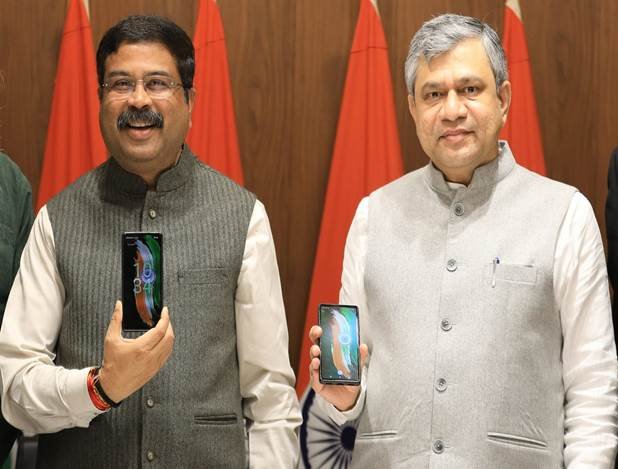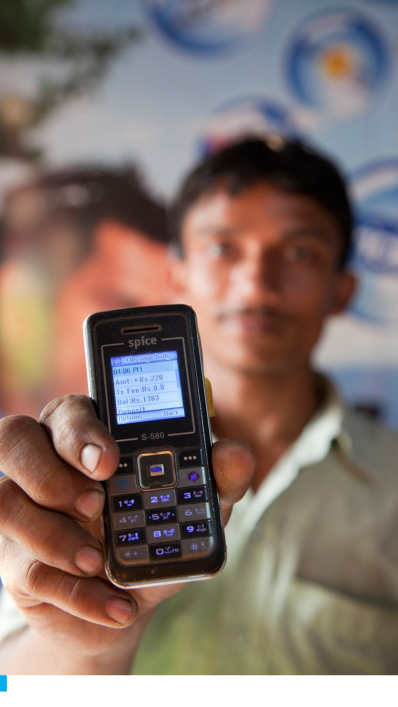In 2007, C-DAC released an operating system with the aim of promoting the adoption of free and open-source software throughout India

On January 2023, IIT Madras and a non-profit entity which incubated it — JandK Operations Pvt Ltd — made a joint announcement of a new made-in-India operating system for mobile devices developed by the latter.

It was called BharOS (presumably short for Bharat Operating System).
Ref: https://swarajyamag.com/technology/bharos-is-not-the-first-made-in-india-operating-system-more-like-the-third-so-whats-new
BharOS is a mobile operating system designed by IIT Madras. It is an Indian government-funded project to develop a free and open-source operating system (OS) for use in government and public systems.
Developer: JandK Operations Private Limited, IIT Madras
Working state: Current
Source model: Open source
Initial release: January 24, 2023
Latest release: BharOS 1
Marketing target: Smartphones
Available in: English, Hindi, Punjabi
Is BharOS based on Linux?
Based on the Linux kernel, BharOS is similar to Google’s Android, but the big difference is that it does not come pre-loaded with any app. Since Android is also based on a Linux kernel, BharOS will resemble Android in its look and feel, but it gives users an option to not use any app they aren’t familiar with.
Ref: https://m.economictimes.com/magazines/panache/home-grown-bharos-its-too-early-to-call-it-indias-operating-system/articleshow/97411426.cms#:~:text=Based%20on%20the%20Linux%20kernel,they%20aren’t%20familiar%20with.
BharOS-A Indian Operating System Launched in 2023

Since the beginning of the 21st century, the invention and popularity of smartphones along with networks has influenced the entire world in the telecommunication revolution. How could our country India remain untouched by this? Today India is the largest consumer of the smartphone market. In such a situation, the less dependence on foreign companies can be reduced, the better, for this there is a need for healthy indigenous manufacturing. In this process, India has invented its own indigenous smartphone operating system BharOS. And it has been recently introduced to the people by the Government of India. Let us know in detail about this new operating system (OS).
What is Operating System (OS)?
Operating system is the primary software that is essential for the operation of any device and other applications installed on it. If the smartphone is considered as its body then the operating system can be called its soul. At present iOS and Android are the mainly used operating systems. iOS is used in Apple’s I-Phone while most of the other smartphones work on Android. BharOS is the latest invented Indian operating system.
What is BharOS? (Indian Operating System)
BharOS is an indigenous smartphone operating system funded by the Indian government. Which has been produced by the Indian Institute of Technology, (IIT) Madras. It is also known as ‘trust’. This indigenous operating system has been developed by JandK Operations Private Limited [a], an incubated firm of IIT Madras, under the Government of India’s campaign ‘Atmanirbhar Bharat’ to reduce the dominance of foreign operating systems. This OS can be installed on commercial off-the-shelf handsets. It will not ship with any pre-loaded apps or share any user data.
[a] https://jandkops.in/Technically there is not much difference between BharOS and Android. Indian Operating System is an Android Open Source (AOS) based operating system. Unlike Android, it doesn’t have default apps or services, meaning users won’t be forced to choose applications they’re unfamiliar with or don’t trust. This OS will not use the services provided by Google, even the default browser will be Duck Duck Go instead of Chrome and Signal will be used for messaging.
This OS is not a completely newly developed software, it is being considered as a forked version of Android. It has been created using the source code of Android without violating the copy rights. Since Android has been based on open source code since its inception, new operating systems can be created using its database. Amazon’s Fire OS is also a similar operating system.
Indigenous operating system from a security point of view
This new OS created by JandK Operations is considered to be similar to Android and iOS in terms of security and features. Like Android, BharOS also offers “native over the air” (NOTA) updates, which means software updates will be automatically downloaded and installed on the device. Apart from this, bug fixing will also be done automatically. The current focus of this new OS is especially on users with high security and privacy needs.
Current use of indigenous operating systems.
IIT Madras clarifies that “BharOS services are currently being provided to organizations that have stringent privacy and security requirements. Its current initial use is allowed for users who automatically handle sensitive information and need secret communications on restricted apps on mobile by accessing private cloud services through private 5G networks.
Features of Indian Operating System
- BharOS is a great option from security point of view.
- It does not have pre-installed services and applications.
- Users will be able to download the app of their choice.
- Users will be able to grant permissions to apps as per their requirement.
- In this, trusted private apps can be used safely.
- Security updates and bug fixes will be installed automatically.
- It will use Private App Store Service (PASS) in which only specific apps meeting the security criteria will be included.
Challenges of BharOS.
- BharOS, being a forked version of Android, cannot use Google’s Play Protect service, so it has to create its own security system. Google Play Protect service keeps the device safe from malware and hacking .[b] https://scifitecknow.com/cyber-security-in-hindi/
- The indigenous operating system cannot use Google Play Store apps, hence it will have to create its own separate app store.
- BharOS faces the challenge of competing with giant operating systems like Android and IOS, which already dominate the market and are excellent in terms of service.
- The challenge is to bring third party app developers under one umbrella for this OS because other similar operating systems from Microsoft, Samsung and Black Berry have failed.
- Convincing smartphone manufacturers to launch phones with this OS is also a big challenge because considering the past failures, no one would want to take the risk of launching a phone with a new operating system.
FAQs
Q.Who has created BharOS?
A. This OS has been developed by IIT Madras firm JandK Operations Private Limited.
Q. What is the Indian alternative to Android?
A. BharOS is the Indian alternative to Android.
Q.What are the main competitors of this OS?
A. Android and IOS are its main competitors.
Q. In which smartphone brand will this OS come?
A. Till now no agreement has been made with any smartphone manufacturer for this OS.
Q. Is the indigenous operating system based on Android?
A. This OS is a forked version of Android.
Q. When will this OS be launched in the market?
A. Its concrete information is not available yet.
Additional Information:
Gates Foundation Releases Open-Source Financial Payments Software
October 17, 2017:
The Bill & Melinda Gates Foundation has announced the release of new open-source software for creating payment platforms that provide the “unbanked” with access to digital financial services.
Designed to provide a reference model for payment interoperability, Mojaloop [a] can be used to overcome barriers that have slowed the spread of financial services among the poor and unbanked populations in the developing world and will be made available free of charge to developers, banks, financial service providers, and companies. Created by the foundation’s Level One Project [b] in partnership with fintech developers Ripple [c], Dwolla [d], ModusBox [e], Crosslake Technologies [f], and the Software Group [g], the software comprises four components — an interoperability layer that connects bank accounts, mobile money wallets, and merchants in an open loop; a directory service layer that navigates the different methods that providers use to identify accounts on each side of a transaction; a transactions settlement layer that makes payments instant and irrevocable; and components that protect against fraud.
[a] http://mojaloop.io/ [b] https://leveloneproject.org/ [c] https://ripple.com/ [d] https://www.dwolla.com/ [e] http://www.modusbox.com/ [f] http://www.crosslaketech.com/ [g] http://www.softwaregroup-bg.com/According to the World Bank, nearly two billion people in developing countries lack bank accounts and cannot access the benefits and security that basic financial services provide. While digital financial services are available in nearly a hundred countries, the expansion of services for the poor has been hampered in large part by a lack of interoperability between digital financial services and payment platforms.
“Interoperability of digital payments has been the toughest hurdle for the financial services industry to overcome,” said Kosta Peric, deputy director of Financial Services for the Poor at the Gates Foundation. “With Mojaloop, our technology partners have finally achieved a solution that can apply to any service, and we invite banks and the payments industry to explore and test this tool. Just as the internet revolutionized digital communication, open-source solutions like Mojaloop can spark innovation and democratize access to digital payments, empowering billions of new customers and driving massive economic growth in developing markets.”

“Bill & Melinda Gates Foundation Releases Open-Source Software to Support Efforts That Expand Access to Financial Services in Developing Countries.” Bill & Melinda Gates Foundation Press Release 10/16/2017.
Bill Gates on Mobile Banking, Connecting the World and AI
Fifteen years into a historic streak of giving, Gates looks forward to the next 15—and sees a world transformed by software

One of the four big initiatives you talk about in the Notes is mobile banking. The Bill and Melinda Gates Foundation has funded projects like bKash in Bangladesh and M-Pesa in Kenya that allow people who have never had checking accounts to do banking with cheap mobiles phones. Does your involvement go beyond funding and into product design?
Continue Reading: https://www.wired.com/2015/01/bill-gates-on-mobile-banking-connecting-the-world-and-ai/
Source: Scifitecknow, Image-Thepamphlet, AIM, Gatesfoundation
Also Read:
